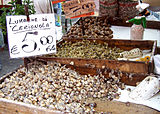- Cerastoderma edule
-
Cerastoderma edule 
Scientific classification Kingdom: Animalia Phylum: Mollusca Class: Bivalvia Order: Veneroida Family: Cardiidae Genus: Cerastoderma Species: C. edule Binomial name Cerastoderma edule
(Linnaeus, 1758) [1]Synonyms Cardium edule Linnaeus, 1758
Cerastoderma edule, commonly known as the common cockle, is a species of edible saltwater clam, a marine bivalve mollusc in the family Cardiidae, the cockles.
This species is found in coastal areas of the eastern Atlantic Ocean. It is widely distributed from Norway to the coast of west Africa.
The common cockle is one of the most abundant species of molluscs in tidal flats in the bays and estuaries of Europe. It is an important species for the fishing industry, and it plays a major role as a source of food for crustaceans, fish, and wading birds. It is commercially fished in the Netherlands and the British Isles. It is also used in aquaculture, farming of cockles is ongoing in Britain, the Netherlands and Portugal.
Cerastoderma edule is able to jump approximately 5 inches at a time, in order to escape predators, which are identified by the many antennae and eyes it has along its mantle edges. It is usually situated with the opening of its shell heading upwards, through which the antennae and eyes extend. It jumps by extending its leg outside the shell and then contracting it.[2]
Human use
This cockle is cooked and eaten in several countries (including France, Germany, Japan, Portugal, Spain and the United Kingdom).
External links
References
- ^ Jan Johan ter Poorten & Serge Gofas (2011). "Cerastoderma edule (Linnaeus, 1758)". World Register of Marine Species. http://www.marinespecies.org/aphia.php?p=taxdetails&id=138998. Retrieved April 20, 2011.
- ^ L. Fishelson, Zoology, 3rd ed. 1979, Hakibutz Hameuchad Pub. House, Israel 1978. Vol I, p.430
Commercial mollusks Marine gastropods - Abalone
- Periwinkle
- Whelk
- Buccinum undatum
- Bullacta exarata

Land and freshwater gastropods - Helix pomatia
- Helix aspersa
- Helix aperta
- Cepaea nemoralis
- Otala lactea
- Escargot
Free-swimming marine bivalves - Scallop
- Queen scallop
- Pecten maximus
- Pecten jacobaeus
- Argopecten irradians
- Placopecten magellanicus
Infaunal bivalves - Clam
- (Atlantic surf clam
- Soft-shell clam)
- Mercenaria mercenaria
- Austrovenus stutchburyi
- Saxidomus nutalli
- Arctica islandica
- Cockle
- Geoduck
- Spisula solidissima
- Paphies ventricosa
- Paphies australis
- Tuatua
- Ruditapes largillierti
- Grooved carpet shell
Sessile bivalves Freshwater bivalves Cephalopods Techniques List of fishing topics by subject Edible mollusks Bivalves Atlantic jackknife • Atlantic surf • Geoduck • Grooved carpet shell • Hard clam • Horse • Mactra stultorum • Blunt gaper • Ocean quahog • Pacific razor • Pecten jacobaeus • Venus • California butterclam • Senilia senilis • Smooth clam • Soft-shell • Triangle shell • Tuatua • Japanese littleneck • Razor clam • Pod razor • Ensis (razor genus) • PaphiesBlue • Mediterranean • New Zealand green-lipped • California • Brown • Asian/Philippine green • Date • Mytilidae (mussel family)Auckland • Eastern • Olympia • Southern mud • Colchester native • Pacific • Portuguese • Windowpane • Rock • Sydney rock • Ostra chilena/Bluff • Gillardeau oysters • Crassostrea ("true oyster" genus)Gastropods Queen • DogBlack foot opihi/Haiwaiian • China • Common European • Rayed Mediterranean • Ribbed Mediterranean • Rustic • Turtle/Talc • Yellow foot opihiLandFreshwaterNeritesInkfish Spineless • BottletailChitons Chiton magnificus • Acanthopleura granulataRelated topics: Oyster farming • Land snail farming • 
This bivalve-related article is a stub. You can help Wikipedia by expanding it.

